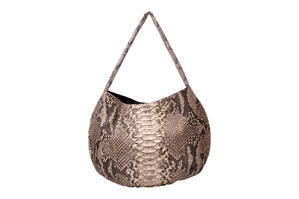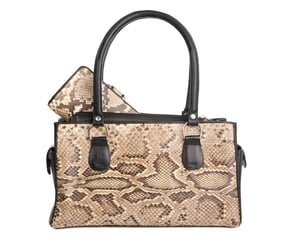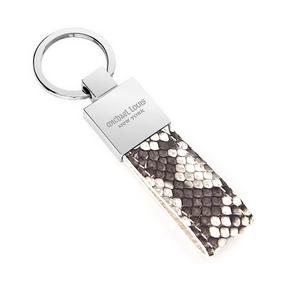
Exotic leather handbags are a strong and distinctive fashion choice that can be a major source of pride for not only their owners, but for the designers who create these beautiful bags for exclusive clientele.
When creating an exotic leather handbag, it’s important to pick the best type of leather for your creative vision and to use it to its best effect. One great option for making handbags is python skin. Why make a python skin handbag? How can you get the most out of your python leather to create the best bag that will attract top-quality clients?
Reasons to Use Python Skin
Python skin is a luxurious material has a variety of benefits that make it the ideal option for your handbag projects. Some of the key reasons why it’s such a good fit for handbag projects include:
Reason #1: Size
Pythons come in many sizes. On the small end, pythons can be 1.5 meters long and 25 cm wide. On the larger end of the spectrum, some pythons can grow to be 6.5 meters long and 60 cm or more in width, which makes this exotic skin ideal for the large panels required for plus-sized handbags.
With many skins, finding large, intact hides of sufficient size to fill a panel for a handbags can be difficult. The large sizes that python skins can reach, however, make acquiring skins of sufficient size for a handbag much simpler. In fact, python skins have been used for even larger projects, such as bed frames, sofas, and tables.
Reason #2: Availability of Grade I Hides
When making a handbag or other object that requires large panels where flaws cannot be easily hidden, you need a hide that has little to no defects such as scuffs, scars, and holes. Such defects can ruin the appearance of the final product.
Because python hides are collected from farms in addition to wild sources, it is much easier to find grade I skins that are free of flaws. Animals that grow in the wild are exposed to any number of potential sources of harm, from prey animals fighting back, predation by other animals, or harm from natural events such as a tree limb or rock falling on the python’s hide and puncturing the skin. Farmers protect python skins from being harmed by eliminating the potential for contact with predators and other forms of accidental damage.
This is one reason why pythons made the list of our favorite exotic leathers to use for handbags and anacondas did not, even though anacondas also reach large sizes and have well-defined scale patterns.
Reason #3: Scale Patterns and Markings
 If you choose to use an unbleached python skin for your handbag, you’ll also enjoy the benefit of having a truly unique, one-of-a-kind pattern in the handbag you create. The natural markings of the python are highly recognizable and distinctive, serving as a badge of authenticity for the handbag. When a handbag is made with unbleached python skin, people will know right away.
If you choose to use an unbleached python skin for your handbag, you’ll also enjoy the benefit of having a truly unique, one-of-a-kind pattern in the handbag you create. The natural markings of the python are highly recognizable and distinctive, serving as a badge of authenticity for the handbag. When a handbag is made with unbleached python skin, people will know right away.
Even bleached, the smooth scales of the python help to accent the look of the handbag, adding texture that can be both seen and felt. Whether with an elegant gloss finish or a more casual matte wax finish, the sleek scales of the python on a handbag are a beauty to behold.
Whether you choose to use an unbleached skin to highlight the natural markings on the hide, or bleach it before dyeing it to create a smoother, more uniform look, a python skin handbag is sure to turn heads wherever it goes, even among gatherings of the rich and famous.
Reason #4: Flexibility
While an untanned python skin can be very rigid, once the hide has been chromed and re-tanned with vegetable-based tanning solutions, it becomes very flexible. This makes python skin leather ideal for products that require the ability to flex, such as large handbags.
Because the python’s hide will flex easily, it is less likely to develop crease marks when it is subjected to being bent, which happens to handbags quite frequently as their owners dig around in them for that one item they’re looking for or are holding the bag in place with their arm while walking about.
Overall, python skin is a high-luxury material that will serve the needs of your most discerning clients extremely well.
Tips for Making Exotic Leather Handbags with Python Skin
To ensure that you make the best python skin handbag to meet your most discerning client’s demands, it’s important to follow a few “best practices” for handling this exotic leather. Here are a few tips to help get you started on your python bag project:
Tip #1: Selecting the Right Python Skin
Before you can start crafting that perfect python skin handbag, you first have to choose which python skins to use. When selecting python skin, consider the following:
- Grade. Handbags normally have very large, open panels. Because of this you typically need large, grade I skins. In a large handbag panel, there is little to no room to hide or work around flaws in a hide.
- Size of the Handbag. Are you creating a small clutch bag, or a big bag? The bigger your project is, the larger the skin you’ll need. If you want to minimize your expenses, you’ll want to make sure that the skins that you order are only as large as you need to fit your panels. However, some handbags are so large that they need to be seamed regardless. If you are flexible, try working from what you can find in stock at tanneries and resellers.
- Colors. Do you have a specific color in mind for your handbags, perhaps to match other items in your collection? When shopping for hides, it’s important to make sure that you get the colors you want so that your final product can match your creative vision. Here, buying your skins directly from a tannery can be helpful, as they can dye the hides any color you want during the tanning process.
- Skin Patterns. One of the most distinctive features of a python’s skin is the patterns of colored scales on it. When ordering python hides, you often have the option of ordering either naturally-patterned skin, or ordering skins that were bleached to remove these patterns. Using natural patterns helps to quickly establish the finished piece as a genuine python skin product, while bleached skins often have a cleaner, more uniform appearance.
Keeping the above in mind while selecting python hides for your handbag project can help you ensure that the skin you get is suitable for your needs.
Tip #2: Using Scrap Material
 With the largest python skins, it is often possible to get multiple panels for a handbag from a single hide. However, material near the tip of the tail tends to be much narrower than material from the midsection. This makes materials near the tip less useful for large sections of the handbag. Instead, use these portions of the skin for straps, trim, zipper pulls and other smaller details.
With the largest python skins, it is often possible to get multiple panels for a handbag from a single hide. However, material near the tip of the tail tends to be much narrower than material from the midsection. This makes materials near the tip less useful for large sections of the handbag. Instead, use these portions of the skin for straps, trim, zipper pulls and other smaller details.
By using material that would otherwise be scrapped, you can get more from your exotic leather purchase, and add a more personal touch to your designs.
Tip #3: Creating Shoulder Straps
When creating handbags that use carry straps, consider buying a few extra small, low grade to use specifically for making carry straps. These skins do not necessarily have to be grade I skins, as you will have a little room to work around flaws in the hide here.
The other way to create shoulder straps would be to use sections of skin from in-between the areas cut out for the larger panels of the handbag. Unfortunately, this limits the length you can get without seaming.
Tip #4: Where to Buy Your Skin
With the above tips in mind, where should you go to buy your python skin for your next handbag project?
For exotic skins, there are two types of businesses that can furnish you with tanned hides:
- Tanneries. These are the businesses that actually process raw hides and turn them into leather. These businesses can process skins “to order,” putting them through tanning processes that best suit your needs. Every order from a tannery will include a surcharge to cover setup costs, whether you order one skin or a hundred skins. Tanneries are the best option for large custom skin orders where time is not an issue.
- Distributors. Unlike tanneries, distributors don’t process the skins themselves. Instead, they order skins from tanneries in bulk, storing them for a quick sale to their own customers (such as you). Most distributors keep a large stock of popular exotic skins in a few different colors. The big advantage here is that the skins you order from a distributor are already finished, so they can ship you your order as soon as it’s complete. However, distributors do charge a markup over what the tanneries charge them for the skins they sell. Distributors are generally best for small orders of commonly-available skin colors and finishes, especially when time is a factor (such as when you’re in a rush to get a prototype finished for a fashion show or other event).
In addition to the two businesses above, you can also place an order with a manufacturer, who will order their skins from either a tannery or a distributor, and then handle the process of turning your skins into a finished product. This is a good choice for designers who don’t have an in-house production team to work with, or who simply want to focus on the design aspect of creating products without having to worry about managing a team of workers.
We hope that you find these tips useful. If you want to learn more about working with exotic leather for a variety of projects, contact Pan American Leathers today, or request a consultation at the link below:,



